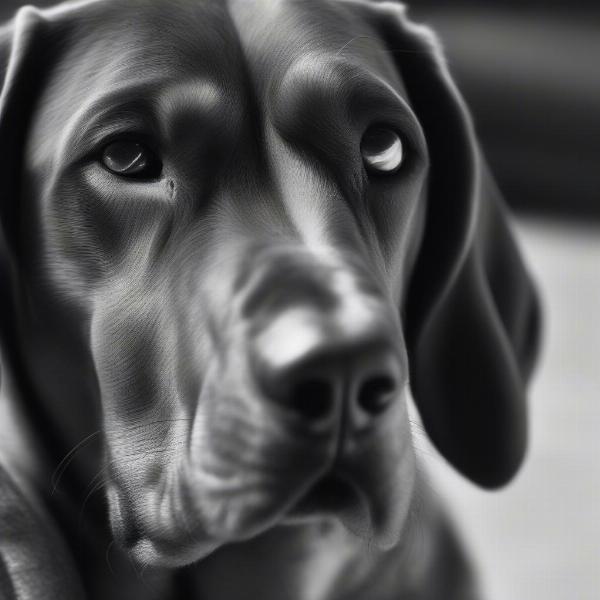Dewlaps are loose folds of skin that hang beneath a dog’s chin or neck. While often associated with specific breeds, this charming characteristic can appear in various dogs. Understanding the dewlap, its potential health implications, and breed-specific considerations will help owners provide the best care for their dewlap-bearing companions.
What Exactly is a Dewlap?
A dewlap, simply put, is excess skin hanging from a dog’s lower neck. It’s a normal anatomical feature in many breeds, ranging from subtle folds to prominent, even droopy, features. Think of it as a dog’s built-in scarf, adding a touch of distinction to their appearance. While some find it endearingly goofy, others see it as a mark of regal dignity. Regardless of personal preference, understanding the nature of a dewlap is essential for responsible dog ownership.
 Close-up of a dog's dewlap
Close-up of a dog's dewlap
Breeds Commonly Associated with Dewlaps
Certain breeds are known for their prominent dewlaps. These include Bloodhounds, Basset Hounds, Neapolitan Mastiffs, and Shar-Peis. While these breeds consistently display this feature, dewlaps can sometimes appear in mixed breeds, a testament to the diverse genetic heritage of dogs. The size and prominence of the dewlap can vary significantly even within the same breed.
Why Do Some Dogs Have Dewlaps?
While the precise evolutionary purpose of the dewlap isn’t fully understood, several theories exist. Some suggest it provided protection during hunts, cushioning the neck from bites. Others believe it aids in scent tracking by holding scent particles closer to the nose. For some breeds, like Bloodhounds, this could certainly be an advantage.
Health Concerns Related to Dewlaps
While dewlaps are generally harmless, they require specific care to prevent health issues. The folds of skin can trap moisture, creating a breeding ground for bacteria and yeast. This can lead to skin infections, irritation, and an unpleasant odor. Regular cleaning and proper drying are essential to maintain a healthy dewlap.
How to Care for Your Dog’s Dewlap
Cleaning a dog’s dewlap is relatively simple. Use a damp cloth or pet-friendly wipes to gently clean the folds, ensuring you reach all the crevices. Dry the area thoroughly afterwards to prevent moisture buildup. For dogs with particularly prominent dewlaps, you might consider using a specialized drying powder to absorb excess moisture.
Dewlaps and Lifestyle Considerations
A dog’s dewlap can sometimes influence lifestyle choices. For example, dogs with large dewlaps might require special bowls to avoid getting their dewlap wet during mealtime. You might also need to be mindful of their dewlap when playing or exercising, especially in muddy or wet environments.
Dewlaps: A Charming Quirk
Dr. Emily Carter, DVM, specializing in canine dermatology, notes, “Dewlaps are a unique characteristic that adds personality to many breeds. While they require a bit of extra attention, proper care can easily prevent most potential health problems. Regular cleaning and drying are key to a healthy, happy dewlap.”
Professor Andrew Miller, a canine geneticist, adds, “The genetic basis for dewlaps is fascinating. It’s a testament to the diversity within canine breeds and the ongoing influence of selective breeding.”
Conclusion
Dogs with dewlaps are undeniably charming. Understanding this unique feature, its potential health implications, and breed-specific considerations will help owners provide the best possible care. By incorporating simple cleaning routines and being mindful of their dewlap during daily activities, you can ensure your dewlap-bearing companion enjoys a healthy and comfortable life.
FAQ
- What causes a dewlap in dogs? Dewlaps are caused by loose skin around the neck, often due to genetics and breed characteristics.
- Are dewlaps harmful to dogs? Not inherently, but they can trap moisture and lead to skin infections if not cleaned regularly.
- How often should I clean my dog’s dewlap? Clean it as needed, especially after meals or if it gets dirty or wet. Daily cleaning might be necessary for some breeds.
- What’s the best way to clean a dewlap? Use a damp cloth or pet-friendly wipes, followed by thorough drying.
- Can I trim my dog’s dewlap? Trimming a dewlap is not recommended and should only be considered under the guidance of a veterinarian.
- Do all dogs with dewlaps have the same health concerns? No, the size and prominence of the dewlap can influence the risk of skin issues.
- My dog’s dewlap smells bad. What should I do? Consult your veterinarian as it could indicate an infection.
ILM Dog is your trusted resource for all things dog-related. We offer expert advice on dog breeds, health, training, nutrition, grooming, and much more. From puppy care to senior dog care, we cover every life stage. Our expertise also extends to travel tips with your canine companion and recommendations on the best products and accessories. For expert advice on dog breeds and selection, contact us at [email protected] or +44 20-3965-8624. Visit ILM Dog today for all your dog care needs.